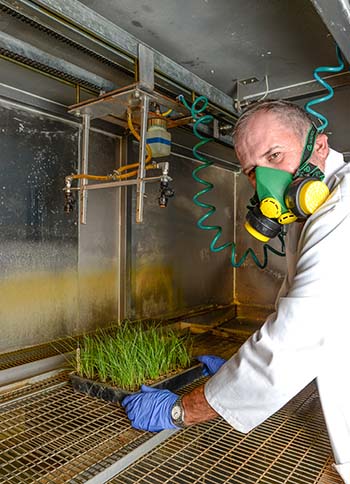GRDC focus delivers gains in herbicide resistance management
The challenge
With the transition to minimum and zero tillage farming systems over the past 30 years, Australian grain growers have become increasingly reliant on herbicides to control weeds.
But herbicide resistance poses one of the greatest challenges to the future viability of the grains industry, costing growers around $200 million annually.
More than 35 cropping weed species in Australia now have populations that are resistant to at least one herbicide mode of action.
The response
GRDC investment into herbicide resistance over the past 25 years has returned a benefit-to-cost ratio of $3.50 for every dollar invested and contributed to the development and adoption of strategies integrating non-herbicide control tools.
At the same time, GRDC has invested in research targeting the mechanisms responsible for herbicide resistance, exploring the biology and ecology of major crop weed species and monitoring the extent of herbicide resistant weed populations.
GRDC’s national investment in herbicide resistance research, development and extension has been channelled through several research partners including the Perth-based Australian Herbicide Resistance Initiative (AHRI), the University of Adelaide and the University of Sydney.
AHRI attracts an annual investment contribution of over $1.5 million from GRDC and its work encompasses three key areas: resistance evolution, resistance mechanisms and resistance management, as well as a communications program.
The University of Adelaide is also undertaking a range of leading weed science research programs addressing integrated weed management, herbicide resistance, weed ecology and crop-weed interactions in agricultural systems.
The University of Sydney is coordinating a multi-faceted weeds research program in conjunction with Charles Sturt University, the New South Wales Department of Primary Industries, the University of Queensland and the Queensland Department of Agriculture and Fisheries.
Recognising the importance of disseminating the outcomes and practical implications of research undertaken by its research partners, GRDC, along with other partners, contributes to WeedSmart – an industry-led initiative to enhance on-farm practices and promote the long-term sustainability of herbicide use.
In addition to progressing herbicide resistance RD&E on a national front, GRDC signed a five-year $45 million Herbicide Innovation Partnership agreement with Bayer CropScience in 2015 to address the global slow-down in chemical weed-control research over the past 20 years and the consequent absence of new herbicides.
The impact
ABARES AGSURF data shows that the cost of chemical use has increased from $78.72 per hectare in the 5-year period 2011-2015 relative to $88.03 per hectare in the period 2016 to 2020 which is a 11.8% increase.
In the same two periods grain income only increased by 5.6% from $629/ha to $666/ha. It is expected that in wet years chemical costs will rise, however, crop yields should also increase. GRDC’s objective is to hold costs constant relative to income.
The 2021 Grower Practice Survey showed that growers were moving into alternative methods to control weed seedbanks including crop toping, chaff carts, chaff lines, seed impact mills, and spraying under wind rows.
Western Australian grain grower Gary Lang has taken a proactive approach to weed control on the family’s 5000-hectare farming operation near Wickepin, southeast of Perth.
“Herbicide resistance represents a significant threat to profitability if you are forced to take country out of production, so we have tried to get on the front foot with our weed management,” Mr Lang said.
“We want to continue making crop choices that are not dictated by herbicide resistance in weeds.
“A key part of achieving that is access to research information and industry expertise. This information underpins every management decision we make.
“The biggest testament to our weed strategies came in 2018 when around 80 per cent of our winter crop was planted before there was any weed germination. We used very little glyphosate as a knockdown herbicide and suffered minimal yield loss due to weeds, which is a fantastic achievement.
“This was mirrored across Western Australia – out of 16 million tonnes of grain harvested state-wide in 2018, probably 12 million tonnes were grown without a knockdown herbicide treatment. That’s what effective herbicide resistance management is all about.”
The future
Herbicide resistance will continue to be a leading investment priority for GRDC as part of its drive to deliver enduring profitability to Australian grain growers.
GRDC remains focused on RD&E investments that improve yield and yield stability and optimising input costs.
The development and implementation of effective integrated weed management options will play a key role in meeting these targets and help industry address challenges such as pressures on herbicides due to resistance, limits to new molecule discovery and management of community expectations.
Was this page helpful?
YOUR FEEDBACK

